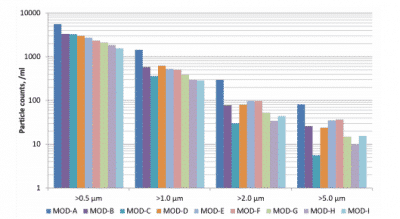Optical Particle Counter Verification of Particle Concentrations in Filtered Seawater for Injection into Oil Reserves
Seawater injection is a secondary recovery technique used in oil reservoirs to replace extracted oil and maintain well pressure. Oil reservoirs are typically found within the small pores of sedimentary rock formations, so it is imperative that the injected seawater does not contain suspended particle matter that can clog these pores and hinder oil recovery. Since untreated seawater contains significant quantities of suspended particle matter it is generally filtered prior to injection into oil reservoirs. Optical particle counters offer an accurate and reliable solution to quantify particle concentrations in filtered seawater used for injection.
Oil reservoirs contained in subterranean rock formations will be under high pressure as the porous rocks are compressed by the considerable weight of rock and Earth above. It is this high pressure that drives the flow of oil to the surface during extraction. If the reservoir pressure is allowed to drop it will slow the flow of oil to the surface and significantly reduce the oil production capacity of the reservoir. Secondary recovery techniques, such as seawater injection, allow the pressure in the reservoir to be maintained by injecting an additional fluid into the reservoir to replace oil that is extracted.
Raw, untreated sea water contains a significant amount of suspended particulate matter that can accumulate inside and block the small micron-sized pores in the reservoir rock. This will limit the amount of water that can be injected into the reservoir and significantly hinder oil recovery. To prevent this happening seawater is generally filtered to an appropriate level of cleanliness before it is injected into the reservoir.
Optical particle counters (OPCs) have been widely used in the pharmaceutical and potable water industries for their accuracy and repeatability. These same instruments can be used to verify particle levels in post-filtration sea water are within acceptable cleanliness limits. Particle measurements can be done continuously using an online particle counter or by measuring samples from multiple locations using a syringe sampler particle counter. Samples collected from multiple locations can be analyzed quickly and without the need for additional sample preparation, which maximizes sample throughput. Both measurement methods enable prompt reaction to any detected failures in the filtration process.
Download this paper to learn more about how a syringe sampling system can be used for evaluation of particle counts in injection seawater.

